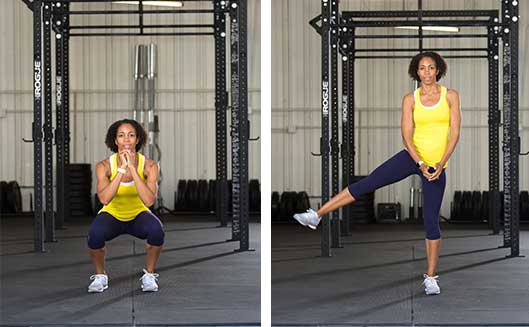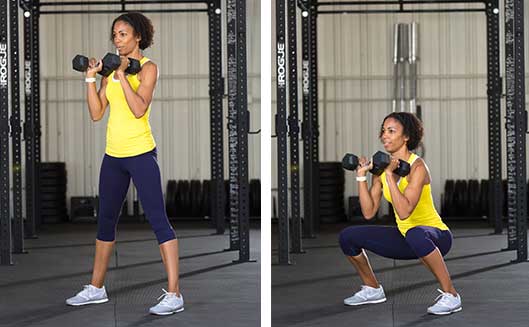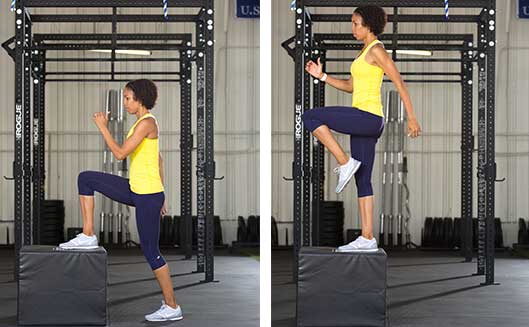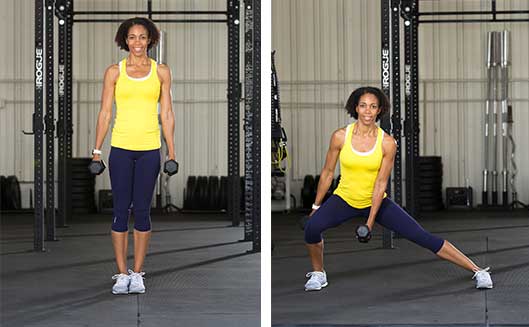Strong glutes are essential, not only for aesthetics, but also for reducing your risk of injury and low-back pain. Plus, powerful glutes enable us to become more agile, jump higher, lift heavier, climb stairs, walk and/or run with less stress to the lower-chain joints, making everyday living and recreational activities more enjoyable and less taxing. Here are two three-exercise circuits that you can do at the home or gym to help build stronger, more powerful glutes.
Build Your Glutes Circuits
Strong gluteal muscles (glutes) not only provide an aesthetic backside, they are important for the overall function of the entire lower chain. The glutes help stabilize your pelvis during walking and running, and you need strong glutes to help with hip extension and forward propulsion. When the glutes are not strong, your entire lower-body alignment may fall out of balance, as other muscles not designed to do the job, such as hamstrings and quadriceps, are subject to overuse and can cause injury such as runner’s knee and iliotibial band syndrome. Pain in the low back can also be a sign of weak glutes. If the glutes are not activating during walking and other forward movement patterns, the psoas major muscle, a hip flexor that connects the low back to the upper leg, can become overstressed causing pain and compression in the lumbar vertebrae.
Here’s a quick overview of the three muscles that comprise the glutes: the gluteus maximus, gluteus medius and gluteus minimus. The gluteus maximus is the largest and most superficial of the three, making up a large portion of the shape of the hips. Its main function is to extend (extension) and laterally rotate (external rotation) the hip. The gluteus medius is located on the outer surface of the pelvis, underneath the gluteus maximus. Its main function is to abduct the leg away from the midline (abduction). The smallest of the glute muscles is the gluteus minimus, a fan-shaped muscle located underneath the gluteus medius. Its main function is to abduct the leg away from the midline and to stabilize the pelvis.
When all three glute muscles function properly, they can produce an enormous amount of power, which is not just a word for athletes. Powerful glutes enable us to become more agile, jump higher, lift heavier, climb stairs, walk and/or run with less stress to the lower-chain joints, making everyday living and recreational activities more enjoyable and less taxing.
Build Your Glute Workout
Perform each of the following three-exercise circuits, in order, for the suggested number of reps and cycles. Exercises can be performed with or without load, at home or at the gym. The only equipment you need is a set of dumbbells (optional) and a step or bench.
Glute Circuit #1: 3 cycles
Hip Bridge

- Lie flat on your back with feet flat, knees bent and arms at your sides. Your feet should be hip-distance apart and positioned close to the glutes.
- Press through the heels and raise the hips up toward the ceiling. Your back, hips and thighs should be in a straight line, at approximately a 45-degree angle to the floor.
- Stay at the top position for 2 counts and then return to the starting position.
- Perform 20 reps.
DB Racked Lunge

- Hold one dumbbell in the right hand at chest level. Step the left foot back, keeping the heel off the floor.
- Lower the back knee to a 90-degree angle so both knees are bent, and then straighten both legs back to standing.
- Perform 12 reps on each side.
- Optional: This exercise can also be performed without dumbbells.
Squat + Side Leg Lift

- Stand with your feet hip-width distance apart.
- Send your hips back, bend your knees and lower down until the thighs are parallel to the floor.
- Press through the heels, stand up and lift your right leg out to the side with your toes pointing forward.
- Lower your right leg, sit back into the squat position and then lift your left leg.
- Perform 12 reps. 1 right leg lift + 1 left leg lift = 1 rep
Glute Circuit #2: 3 cycles
DB Wide Squat

- Stand with feet wider than hip-distance apart and toes turned outward to 10 o’clock and 2 o’clock. Hold a pair of dumbbells at chest level.
- Send your hips back, bend your knees and lower down until the thighs are parallel to the floor.
- Press though the heels and stand back up to the starting position.
- Perform 12 reps.
- Optional: This exercise can also be performed without dumbbells.
Step Up

- Place your right foot on a bench, step or sturdy chair.
- Push off your right foot and step up onto the bench with both feet. Step down with the left foot, keeping the right foot on the bench.
- Perform 12 reps on each side.
- Optional: Hold the dumbbells by your sides.
DB Alternating Side Lunge

- Stand in a wider-than-shoulder-width stance, with toes pointing forward; hold a pair of dumbbells by your sides.
- Keeping your left leg straight, shift your weight to the right leg, sit your hips back, and lower down until the right thigh is parallel to the floor.
- Push back to the starting position and switch sides, shifting your weight into the left leg.
- Perform 12 reps: 1 right + 1 left = 1 rep
- Optional: This exercise can also be performed without dumbbells.




 by
by 







 by
by